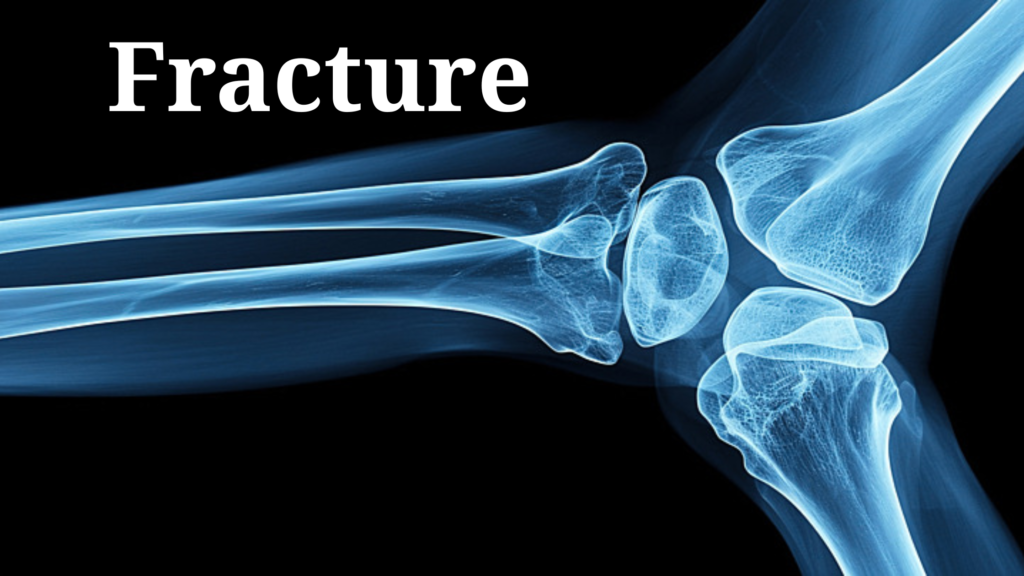A fracture is a break or crack in a bone, which can occur due to trauma, accidents, or underlying conditions that weaken the bones. Fractures can range from small cracks to complete breaks, and the severity can vary depending on the cause and the location of the break.
🦴 What is a Fracture?
- A fracture occurs when a bone is subjected to more force than it can handle, leading to a break. This can happen due to trauma (like a fall or accident) or diseases that weaken bones (like osteoporosis): 💥🦵
⚠️ Types of Fractures:
Fractures are classified based on their location, severity, and how the bone breaks. Here are the common types:
- Closed Fracture (Simple): The bone breaks but does not break through the skin: 🦴🚫🩸
- Open Fracture (Compound): The bone breaks and pierces the skin, increasing the risk of infection: 🦴🔪🩸
- Complete Fracture: The bone is completely broken into two or more pieces: 💔🦵
- Incomplete Fracture: The bone is cracked but not completely broken through, such as a greenstick fracture (more common in children): 🦴⚡
- Transverse Fracture: A straight horizontal break across the bone: ➖🦵
- Spiral Fracture: A twisting or spiraling break around the bone, often caused by a twist or rotation injury: 🌀🦵
- Comminuted Fracture: The bone is broken into several pieces, usually after a high-impact injury: 💥🦴💥
- Impact Fracture: One piece of bone is driven into another, typically after a fall or collision: 🔨🦴
- Stress Fracture: A small crack in the bone due to repetitive stress or overuse, often seen in athletes: 🏃♂️🦵
💥 Causes of Fractures:
- Trauma: Falls, accidents, or direct impact to the bone can cause a fracture: 🏃♀️💥
- Osteoporosis: A condition that weakens bones, making them more susceptible to fractures, even with minimal force: 🦵🦴⚠️
- Sports injuries: High-impact activities or contact sports often lead to fractures: ⚽🏀⚾
- Motor vehicle accidents: Collisions can result in fractures, especially to the arms, legs, and ribs: 🚗💥🦵
- Diseases: Conditions like cancer, osteogenesis imperfecta (brittle bone disease), or infection can weaken bones, increasing the risk of fractures: 🧬💔
🧑⚕️ Symptoms of a Fracture:
- Pain: Sharp or aching pain around the fracture site, especially when moving the limb: 🤕🦴
- Swelling: Swelling or bruising around the area of the break: 🦵💥
- Deformity: The bone may look misaligned or out of place: 🦴↩️
- Inability to move the affected area: Loss of function, especially in fractures of the limbs or joints: 🦵🚫
- Crepitus: A grating or crunching sound when moving the bone (often associated with open fractures): 🔊💥
🩺 Diagnosis:
- Physical examination: Doctors will check for deformities, swelling, and tenderness: 🧑⚕️🦴
- X-rays: The most common way to diagnose fractures, helping to show the location and severity of the break: 📸🦵
- CT scans or MRIs: These may be used for complex fractures or to assess surrounding tissues: 📊🧠
- Bone scans: Used to detect stress fractures or fractures that might not show up on regular X-rays: 🧑⚕️🦵
💊 Treatment:
Treatment for fractures depends on the type and location of the fracture, as well as the age and health of the individual:
- Immobilization: The first step is usually to immobilize the bone using a cast, splint, or brace to prevent further movement: 🦵🦺
- Pain relief: Painkillers such as acetaminophen or NSAIDs (like ibuprofen) help manage pain: 💊🔥
- Reduction: If the bone is out of alignment, the doctor may need to reposition it (called reduction), either through a non-surgical or surgical procedure: 🔨🦴
- Surgery: In severe fractures (like comminuted fractures), surgery may be required to realign the bone and use rods, plates, or screws to hold the bone together: ⚙️🦵
- Bone healing: After treatment, the bone will heal over time (typically in 6-8 weeks for most fractures), depending on the severity: ⏳🦵
⚡ Complications:
If not treated properly, fractures can lead to complications:
- Infection: Especially with open fractures, where the bone punctures the skin: 🦠🩸
- Non-union: Sometimes, bones don’t heal properly, leading to a non-union fracture that requires further surgery: 🦴❌
- Blood vessel or nerve damage: The break could damage nearby blood vessels or nerves, leading to further issues: 💔⚡
- Osteomyelitis: An infection in the bone that can occur, especially after surgery: 🦠🦵
🌱 Healing and Recovery:
- Rest: After a fracture, rest is essential to allow the bone to heal properly: 🛏️
- Rehabilitation: Physical therapy is often needed to restore strength and movement once the bone has healed: 🧑🦱🏋️♀️
- Diet: Eating foods high in calcium and vitamin D can help support bone healing: 🧀🍊
- Follow-up: Regular check-ups with a doctor or specialist to monitor healing and ensure proper alignment: 🩺🔄
